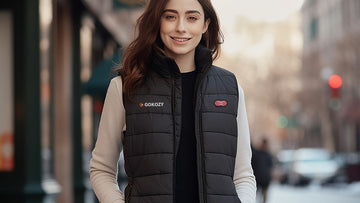Introduction
Importance of Heated Vests
As winter approaches, staying warm becomes a top priority. Heated vests have gained popularity as a modern solution to this age-old problem. But what makes these vests so effective? The answer lies in their insulation.
The Role of Insulation
Insulation is the unsung hero of any heated vest. It's what traps the heat and keeps you warm. But with so many types of insulation available, how do you choose the best one for your heated vest? Let's dive in.
Why Choose the Right Insulation?
Warmth
The primary role of insulation is to provide warmth. The effectiveness of insulation is often measured by its warmth-to-weight ratio. The higher the ratio, the better the insulation material is at trapping heat.
Weight and Mobility
Nobody wants to feel like they're wearing a suit of armor. The weight of the insulation material can affect your mobility. Lighter materials that still provide good insulation are generally preferred.
Breathability
If you're active, you'll sweat. Breathability in an insulation material ensures that moisture is wicked away, keeping you dry and comfortable.
Durability
Your heated vest is an investment. The durability of the insulation material can affect how long your vest remains effective.
Types of Insulation
Down Feather Insulation
Down feathers offer an excellent warmth-to-weight ratio but can lose effectiveness when wet. They are also more expensive and require special care.
Fleece Insulation
Fleece is lightweight and retains heat well, even when damp. It's also generally more affordable than down.
Synthetic Fiber Insulation
Synthetic fibers like polyester mimic the properties of down and are hypoallergenic. They are also easier to care for and are effective even when wet.
Graphene Lining
Graphene is known for its exceptional heat conductivity and is used to distribute heat evenly across the vest.
Cotton Insulation
Cotton is a natural, breathable option, but is less effective in wet conditions.
To assist you in evaluating the various insulation options, the table below provides a summary of their essential attributes.
|
Insulation Type |
Warmth |
Water Resistance |
Moisture Management |
Durability |
|
Down Feather |
High |
No |
Moderate |
Requires Special Care |
|
Fleece |
Moderate |
No |
Excellent |
Good |
|
Synthetic Fiber |
Moderate |
Yes |
Good |
Excellent |
|
Graphene Lining |
Good |
No |
Excellent |
Good |
|
Cotton |
Good |
No |
Moderate |
Moderate |
Comparing Insulation Types
Warmth-to-Weight Ratio
Down feathers generally offer the best warmth-to-weight ratio, followed by synthetic fibers and fleece.
Moisture Management
Synthetic fibers and fleece perform better in wet conditions compared to down and cotton.
Cost and Maintenance
Down is generally more expensive and requires special care, while synthetic fibers are more budget-friendly and easier to maintain.
Factors to Consider
Activity Level
Your level of activity can influence the type of insulation you need. For high-energy activities, breathable materials like fleece or synthetic fibers are ideal.
Weather Conditions
If you're going to be in wet conditions, avoid down and opt for synthetic fibers or fleece.
Personal Preferences
Some people have allergies to certain materials, like down. Always consider your personal needs when choosing insulation.
How to Test Insulation
Thermal Imaging
Some brands offer thermal imaging to show the effectiveness of their insulation.
Real-world Testing
Nothing beats trying out a few different vests in real-world conditions to see which insulation type works best for you.
Popular Brands for Heated Vests
There are several reputable brands like GOKOZY, Venustas, and others that offer a variety of heated vests with different types of insulation.
Common Mistakes to Avoid
Don't just go for the cheapest option; consider all factors like warmth, weight, and durability before making a decision.
Conclusion
Choosing the right insulation for your heated vest is crucial for staying warm and comfortable. By considering factors like warmth, weight, and breathability, and by comparing different types of insulation, you can make an informed decision that suits your specific needs.
FAQs
-
What is the best type of insulation for heated vests?
- There's no one-size-fits-all answer; it depends on your needs.
-
Is down insulation good for wet conditions?
- Generally, no. Down loses its insulating properties when wet.
-
How do I care for a down-insulated heated vest?
- Down requires special care, including specific washing instructions.
-
Can I use thermal imaging to test the effectiveness of insulation?
- Yes, some brands offer this feature.
-
Are heated vests with synthetic insulation hypoallergenic?
- Generally, yes. Synthetic fibers are usually hypoallergenic.






